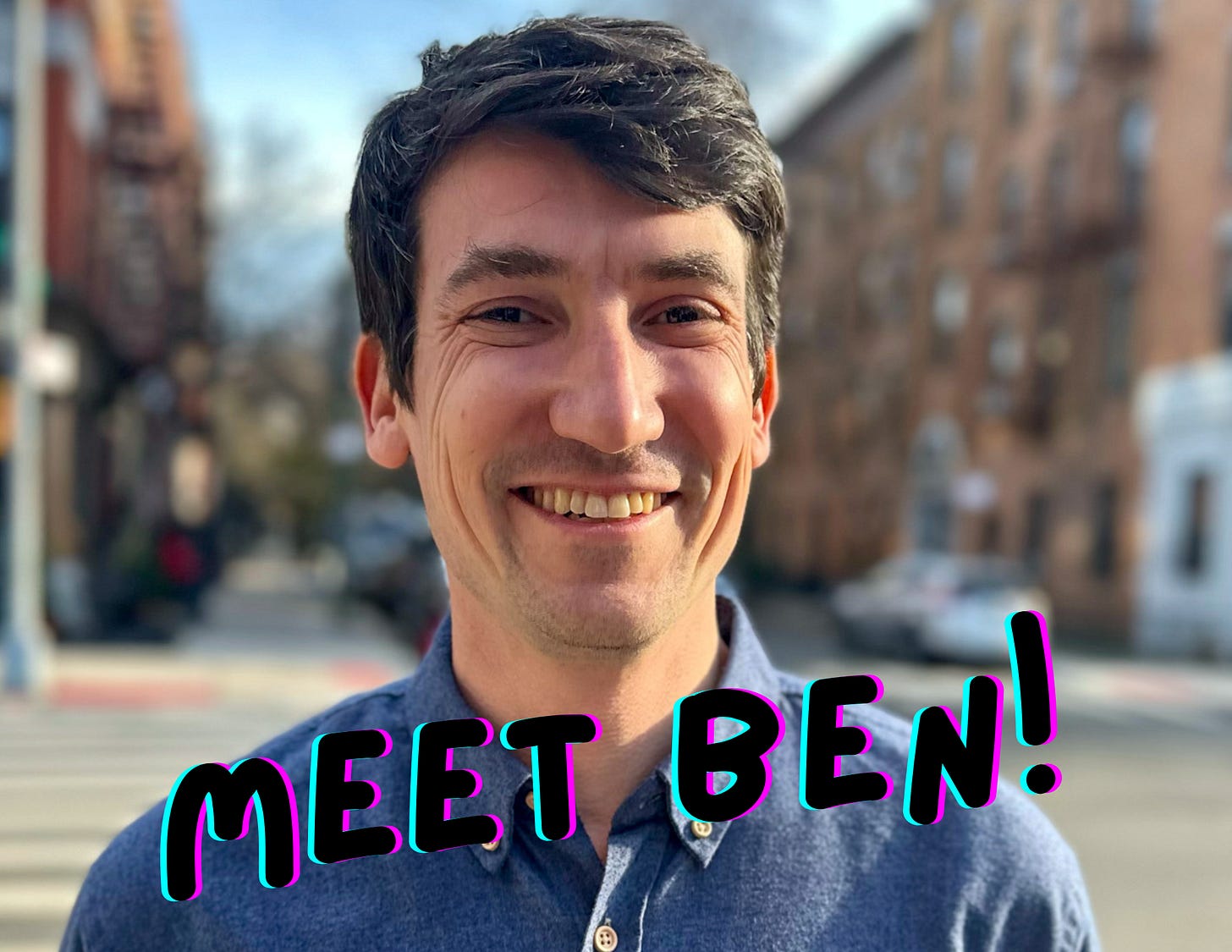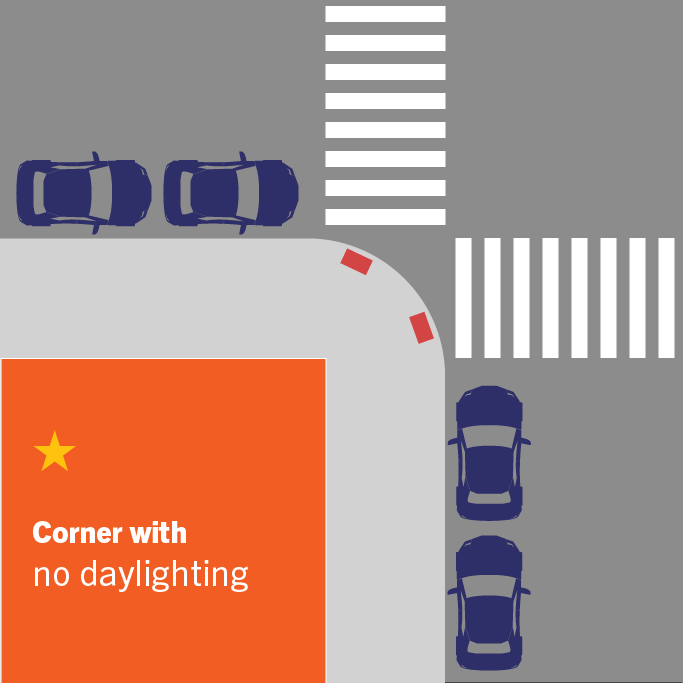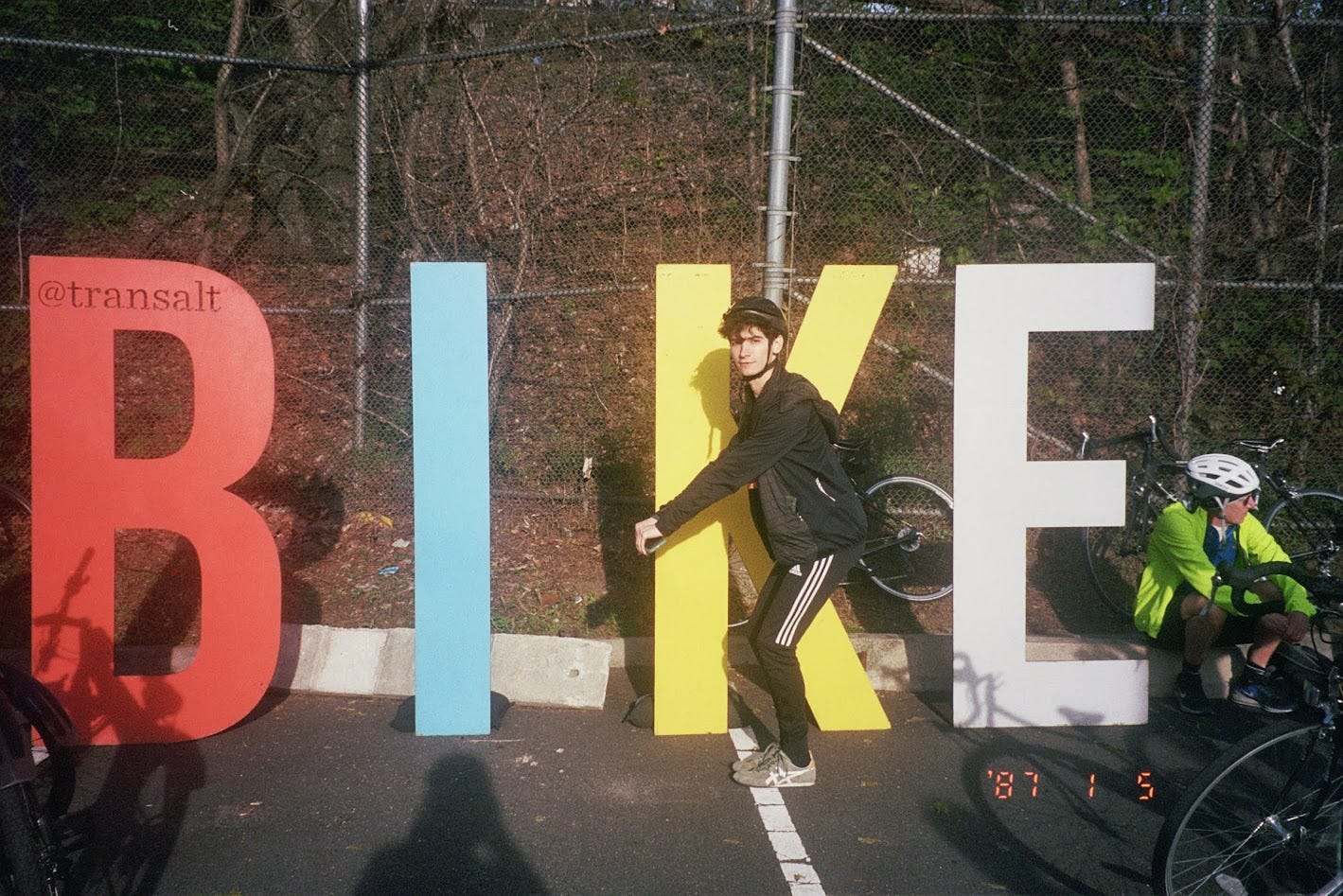How to Fight for Safer Streets
An interview with new Transportation Alternatives director, Ben Furnas
Leg Day is a newsletter about the pursuit of joy as a city cyclist.
I lived in New York City six years before I felt comfortable enough to ride a bike here. Once I mustered up the courage to try, I came to realize the streets had been made way safer for cyclists than I had ever realized as a pedestrian. There were plenty of painted bike lanes near my apartment that connected to even better protected lanes. There were tons of Citi bike stations for days where I only wanted to do a one-way trip, or feel the POWER of an electric motor for an afternoon. And there were still many sections of street completely closed to vehicular traffic, where I could ride with the same abandon I had as a suburban child.
At the time, it really felt like the situation was only getting better for cyclists. The city had promised to install 50 miles of new bike lanes the year I started cycling. Congestion pricing, a $15 toll to enter lower Manhattan that passed in the 2019 New York state budget in 2019, was finally going to be implemented, which would completely change how it would feel to bike to my office job.
My optimism has been challenged. The Adams DOT fell over 10 miles short of its bike lane installation mandate for 2023, and nearly 30 miles short in 2024. And last summer, Kathy Hochul put a pause on Congestion Pricing weeks before it was set to take effect. Then, Donald Trump won the presidential election. He is expected to bring in a national transportation policy that is actively opposed to “Vision Zero” projects (those that try to prevent people from being killed by cars) and promotes autonomous vehicles as the solve to traffic1.
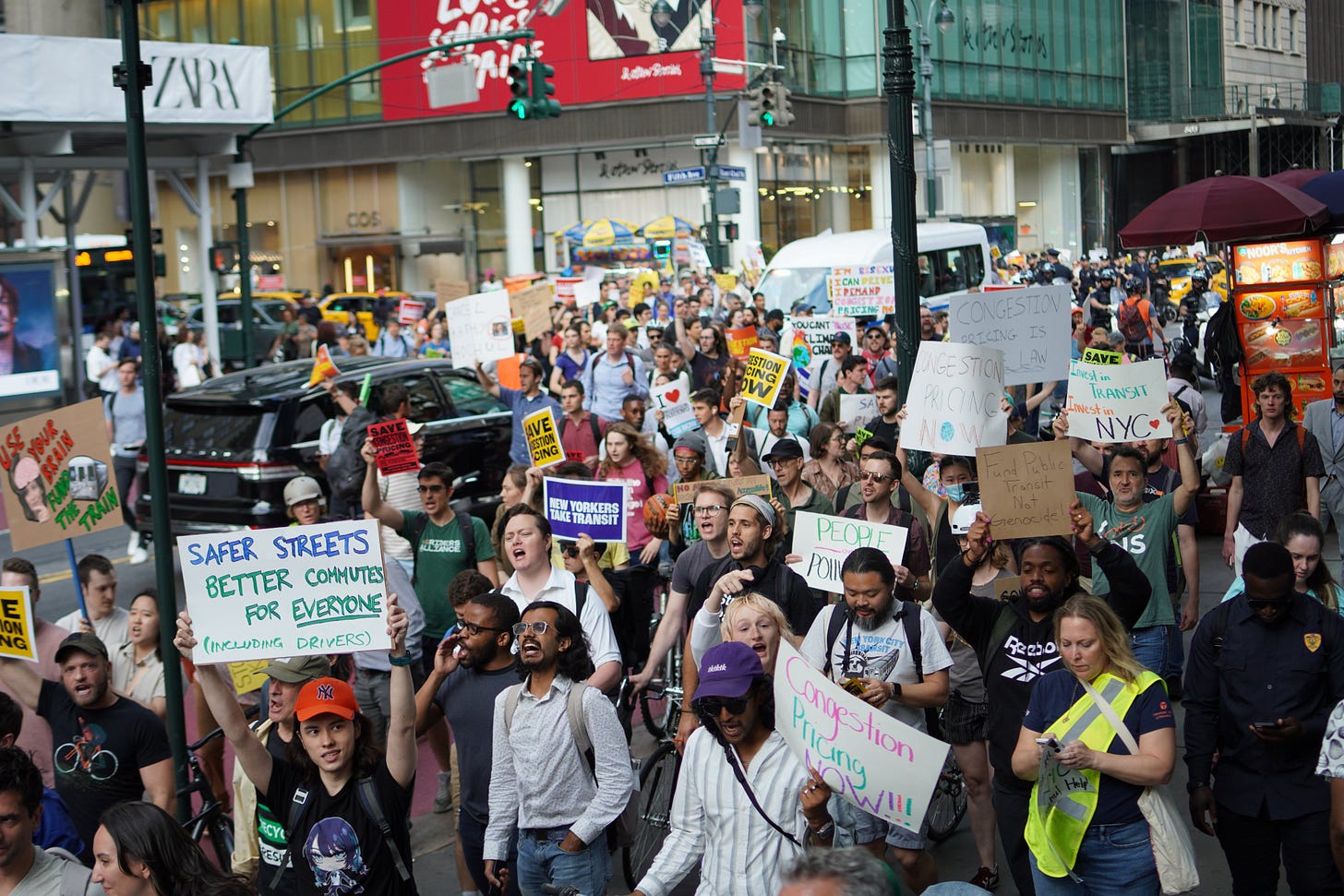
Shortly after Hochul announced the congestion pricing pause, I saw a post from Transportation Alternatives about a rally to petition Kathy Hochul to re-instate the toll. I had just been laid off from the WSJ, thereby freed from a standards policy that prevented me from taking public political action, so I decided to go. I found myself in a crowd of thousands of other New Yorkers who wanted exactly what I did: more room to walk and bike and more money for our aging transit system.
Hochul did end up re-instating congestion pricing after the 2024 election at the lower rate of $9 during a very weird press conference where she seemed unable to make the (obvious) case that majority of people entering the toll zone each day do so on transit. But once Trump made good on his campaign promise to end the toll program—posting a limp fake magazine cover to Instagram depicting himself as a king—Hochul seemingly found her voice. “If in some world they are successful [in cancelling the program], the next time you’re stuck in traffic, your train is delayed, think about this,” she said, literally holding a print out of the post.
Experiencing this whiplash has been weirdly motivating. If Hochul can change her mind this quickly, it feels like anything is possible. These days, I feel more energized to work to advocate for the kind of city I want to see than ever.
So, when I learned Transportation Alternatives had hired Ben Furnas as its new executive director, I knew I wanted to speak to him about how I and other city cyclists could get more involved. Furnas officially took the job at the beginning of the year. As far as I know, this is the first long-form interview he’s done with press.
This interview has been edited for length and clarity.
What is Transportation Alternatives?
I describe us as New York’s premier walking, biking, and public transit advocacy organization. Among all those things, the common denominator is safe streets. We are imagining a city that is a little bit less reliant on private automobiles. Depending on the audience, I can go deep on the full transformations beyond the car. But at it’s most basic level, I aspire for us to be an organization for all New Yorkers from all walks of life, no matter how they get around, no matter what neighborhood they live in. I think all of us, even if we drive a car sometimes, are pedestrians a lot of the time. Everyone benefits when the streets are safer for walking around. And, for as many people there are who currently bike around the city, there are a huge number of others people who, if it felt a bit more convenient or safe or pleasant, would be interested in doing it too.
How’d you end up as its director?
I spent eight years in New York City Hall. I worked on the Bill de Blasio mayoral campaign and helped him put together some of his transportation and street safety policy. I was central to generating the campaign’s Vision Zero policy document. I then came into City Hall in 2014 and worked for First Deputy Mayor Tony Shorris, tasked with organizing the first Vision Zero Task Force. I worked with folks across the agencies to try to reduce death and serious injuries on our on our streets. I spent 8 total years at City Hall, eventually becoming the director of the Mayor's Office of climate and sustainability.
I had a pretty close working relationship with with Transportation Alternatives and a huge amount of affection for the organization and its great combination of neighborhood-rooted outside advocacy with really thoughtful insider persuasion: inside game, outside game. And, having lived here since 2009, I have a huge amount of affection for New York.
I really loved doing environmental and climate work in New York City. Our greenhouse gas emissions per capita are way lower than everywhere else in the country just because we take the subway a lot more. I used to joke that my favorite electric vehicle is a subway car.
I have a huge amount of appreciation for how much control our city government has over our streets and the possibilities of what our streets could like. I’ve been bicycling the basically the whole time I’ve lived here and really love it as a way to get around. I live in Park Slope with my two young daughters and my wife, so I definitely see a lot of this work through the eyes of a parent of young kids. They’re two and five. They both have little scooters and are like, total nutcases on the sidewalk. It’s exciting to have them get around like that, but there’s part of my mind that’s always a little worried about them. It just feels like the possibilities for how much better it could be are so vast. I’m excited to get to work at a place where we get up every morning and think about how to make the city more human and livable and nicer for people of all ages.
You started on January 1, how has the job felt so far?
You know, it's been a hugely exciting time. Slightly harrowing, but mostly exciting! Congestion Pricing just reflects an enormous transformative possibility for the streets of Manhattan. I think it’s shown what is really possible when we thoughtfully manage the vehicular traffic on our roads. There’s just a huge amount of quality of life benefits for people who are walking and biking and taking transit, but even for people who are driving themselves. And we’re seeing how much more pleasant life can be if streets aren’t totally clogged with traffic and people driving really recklessly.
There’s still an enormous amount of work left to do. I am someone who has been in these circles long enough that I can remember New York City streets before the Janette Sadik-Khan era of the Department of Transportation started the protected bike lane revolution. And in the subsequent decade, there’s been a huge amount of build out of both the protected bike lane network and the Citi bike share system. Ridership is through the roof compared to where it was in the last decade.
But anyone who bikes around knows that protected bike lanes disappear in weird places, bike lanes are blocked too often. It’s not quite as convenient and easy and safe to ride as it could be with a little more focus and attention. But that’s why we get up and come to work here!
I’ve noticed that Transportation Alternatives gets name checked a lot by people who are really opposed to street design that’s less car-centric.2 But you also get criticism from people who are operating in better faith. How do you speak to people who are frustrated by the changes they’re seeing?
Yeah, it’s true and unfortunate that there are some fairly ill-intentioned people who have seized on changes to the streets as an issue that can divide and polarize people against each other. I aspire to be a person of goodwill who can engage with everyone, even if they’re a bit skeptical to some transformations, to try and show how they can be really beneficial and helpful for neighborhoods across the city. When I talk to folks, there’s a pretty unified sense that the status quo on our streets isn’t particularly pleasant or working for them. People feel like there’s too much traffic, that it’s harder to get around than it should be.
In some cases, we’re dealing with zero sum dynamics and we have to make hard choices. But I think there are actually a lot of ways to be investing in our streets that most people will feel as a major benefit. Trying to find what those pieces are and how we can move them forward is what TA aspires to do.
People come to this work through a lot of different doors, but all of us are motivated to make streets safer. Some people who are involved at TA or New York Families for Safe Streets have lost a loved one in a traffic crash. That can be an extremely motivating for advocacy, to make sure that type of tragedy doesn’t happen to anyone else. Others come to us because they like to bike around the city or have to bike for their job. They like having an advocacy home for higher quality bike infrastructure and more respectful treatment of people who are biking around.
Can we talk more about congestion pricing? Though it seems to be doing a ton of good for the bottom half of Manhattan, the Trump Federal Highway Administration has basically told the MTA to cancel it, or else. What is Transportation Alternatives doing to support the effort to keep it in place?
We’re trying to do a couple of things at once. There’s an ongoing lawsuit about whether the state of New York will be able to keep the cameras on and the program going. We’re part of a coalition of different groups that are supporting the lawsuit.
We’re also continuing to build the external public case for it. So collecting and spreading data about how well it’s working. We want to make sure that when you’re talking to your friends, you have like, five reasons why congestion pricing is working and out to keep going.
The biggest thing that most people can do right now to support us is to call the governor. Call Kathy Hochul and thank her for standing strong to Donald Trump and keeping congestion pricing going. Of all the individual politicians who have the power to stand up to Trump on this particular issue, Kathy Hochul is one of them. I think she needs to feel that the people in New York have her back and appreciate her for fighting for this. Over the years, she was a little bit lukewarm and squeamish on the policy. We all remember that she delayed it last summer. But I think she and her team have seen how well it’s working and how valuable it is to reduce congestion and fund vital transit improvements.
What are some of the other issues you all are working on?
There are three things of a similar city-wide scope. In Albany this session, we’re working on the reauthorization of speed camera program and have an ambition to crack down on what we call “super speeders.” These are drivers who rack up a huge number of tickets. We’ve found that these kinds of drivers are disproportionately responsible for a lot of the serious injuries and deadly crashes on our streets. We have a proposal for a law that would require the installation of speed limiters on the cars of drivers that would stop them from speeding.
We’re also working on a daylighting bill, which would change the rules that govern every single intersection in the city. It’s not about restricting parking, it’s about adding physical interventions that shorten crossing distances for pedestrians and make sure that cars take turns slower.
Another thing we’re going to be talking about more over the summer and into the fall is what a really high-quality all-ages and abilities bicycling network would look like for New York City. This will have to be built piece by piece, project by project. But we want to raise the ambition of our bike lane advocacy and talk about the possibility of a really high quality network. It’s not just about individual bike lanes and routes that take you from protected lane to door zone bike lane to shared roads. We want to have everything feel more cohesive.
How can our readers get involved in helping you make these three things happen?
Well, obviously donations and membership in the organization is always helpful. We use these resources to support both the staff and our local activist committees in every borough. These are great doors into our work, where you can find some level of community among other people who are passionate about these issues. If you have a geographic specific project your passionate about fighting for, this is where that work would begin.
We also have a whole suite of events that are combination community building and power building exercises, to really show folks that there are lots of people who care about the same things. They can be a true show of force that can both be very inspiring and get more people more politically involved. We have one coming up pretty soon called the 5 Boro Pizza Challlenge: it’s a fun race to get between pizza parlors in every borough without a car. A lot of people will be biking, but you can also take the bus, the train, the ferry or walk.
Final question for you: What’s your favorite place to bike in the city?
Oooh, the Shore Parkway. During the pandemic, I would bike down to Owl’s Head Park and just look at the Statue of Liberty. This was before my children took up the amount of time in my life they currently take up in my life. Biking down to Owl’s Head Park with a book on a warm summer day is just delightful.
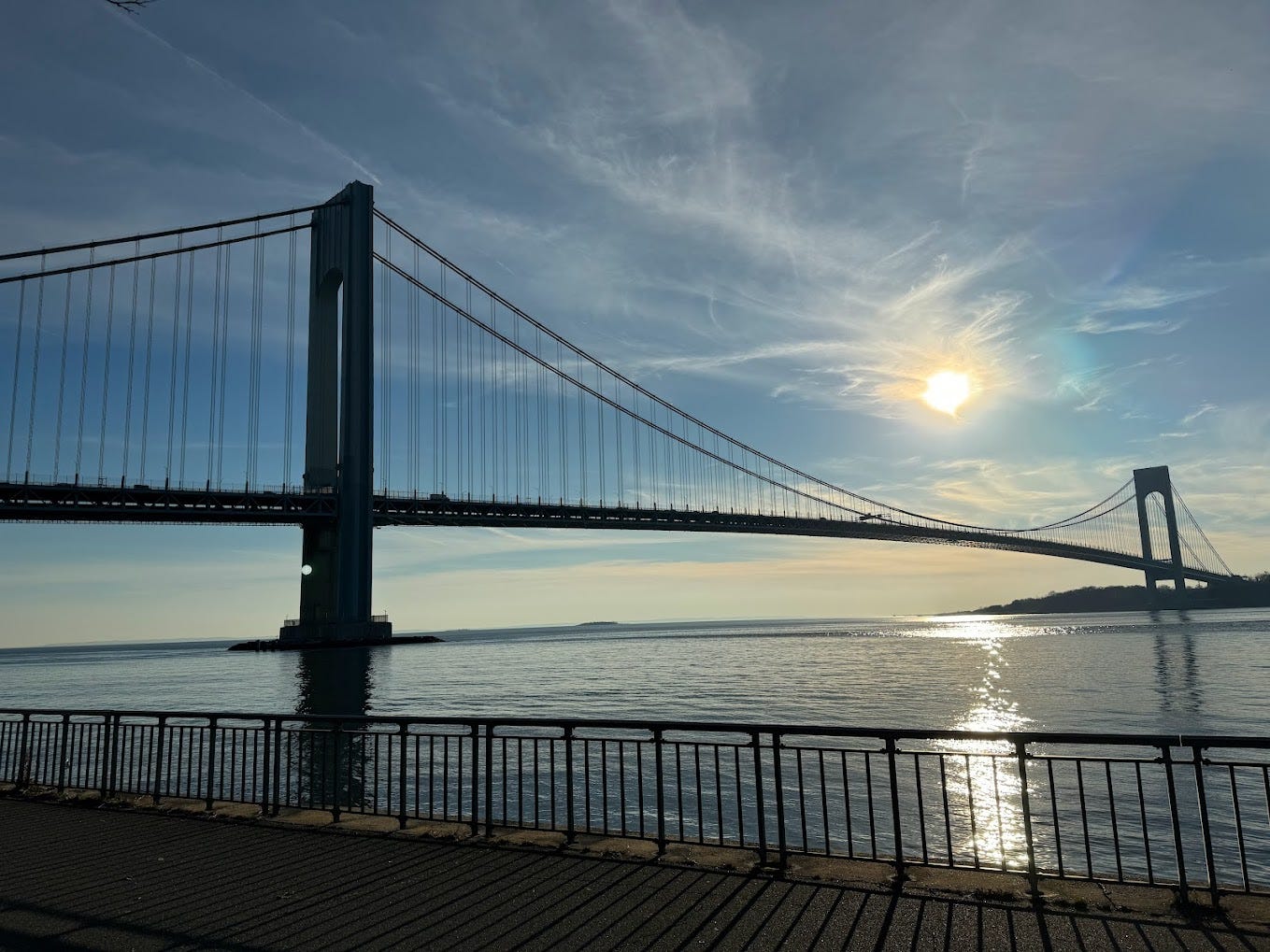
Thank you for reading Leg Day! If you liked this piece, you might enjoy reading my essay on the Lycra Bro or my interview with bike fitter AM Van Doren.
This is a whole THING that I don’t want to get into. If you want more information on why I don’t believe self-driving cars will save us, I recommend this video from Not Just Bikes.
There’s a guy on Twitter who refers to the NYC DOT as the Department of Transportation Alternatives. I won’t link to him because he’s obsessed with posting screenshots of cherry picked data about rampant violent crime. (One thing I will link to: a recent story about how even though violent crime has been decreasing this year, COMPLAINTS about violent crime have quadrupled.)





